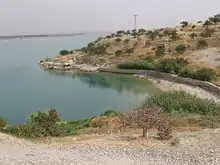Apamea (Euphrates)
Apamea or Apameia (Greek: Απάμεια) was a Hellenistic city on the left (viz., the eastern) bank of the Euphrates, opposite the famous city of Zeugma, at the end of a bridge of boats (Greek: Ζεῦγμα zeugma) connecting the two, founded by Seleucus I Nicator (Pliny, v. 21). The city was rebuilt by Seleucus I. The site, once partially covered by the village of Tilmusa (formerly Rumkale), Şanlıurfa Province, Turkey, is now flooded by the lake formed by the Birecik Dam (Birejik Dam).[1][2]
 Apamea lies below these waters | |
 Shown within Turkey | |
| Location | Şanlıurfa Province, Turkey |
|---|---|
| Coordinates | 37.0667°N 37.8836°E / 37.0667; 37.8836 |
The ancient term Zeugma actually referred to the twin cities on the opposing banks of the river. Today the name Zeugma is usually understood to refer to the settlement on the west bank, called Seleucia (Greek: Σελεύκεια) after the founder, while the one on the East bank was called Apamea after his Persian wife Apama.[3]
See also
References
-
 This article incorporates text from a publication now in the public domain: Chisholm, Hugh, ed. (1911). "Apamea". Encyclopædia Britannica (11th ed.). Cambridge University Press.
This article incorporates text from a publication now in the public domain: Chisholm, Hugh, ed. (1911). "Apamea". Encyclopædia Britannica (11th ed.). Cambridge University Press. - Smith, William (editor); Dictionary of Greek and Roman Geography, "Apameia", London, (1854)
- Archeological Site of Zeugma
External links
